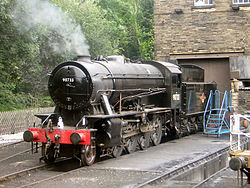
War Department "Austerity" 2-8-0, WD No. 79257 is a preserved British steam locomotive. It is the only survivor of its type. Originally built by the Vulcan Foundry in 1945, works No. 5200, it was given the WD No. 79257. During the liberation of Europe, it was transferred to mainland Europe with the British Army. [1] [2]

